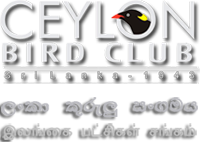


INTRODUCTION
Sri Lanka is a small island located close to the equator with a very rich diversity of eco systems. Many types of forest habitat including wet ever green forests, sub-montane forests, montane forests, intermediate forests, dry forests as well as arid scrub lands and sand dunes are found within its land area of approximately 64,550 sq km. This diversity of eco systems coupled with the fact that it is an island has resulted in many forms of life to thrive in various habitats and to evolve in to endemic forms.
According to the available data the forest cover of the country is as follows
- Wet evergreen forests – 2.14%
- Sub- montane forests – 1.04%
- Montane forests – 0.5%
- Intermediate forests – 3.69
- Dry Forests – 16.49
- Arid scrublands - 0.5%
There are a number of categories of Protected Areas in the country managed by different authorities. Areas designated as Strict Natural Reserves (SNR), Nature Reserves (NR), National Parks (NP), Buffer Zones (BZ), Jungle Corridors (JC), Marine Reserves (MR) & Sanctuaries are managed by the Department of Wildlife Conservation (DWLC). Conservation Forests (CF), National Heritage Wilderness Areas (NHWA) and Forest Reserves (FR) are protected by the Forest Department. All these are areas maintained for the protection of habitat & biodiversity and harming any birds or animals, disturbing their nesting or breeding places causing any damage to a tree or plant within such area shall amount to the commission of an offence carrying heavy penalties and punishable in a Criminal Court of Justice. Except for a handful of species all most all wild birds and animals as well as a number of plants species are protected by law and causing any harm to them in or outside any protected area will also amount to the commission of an offence attracting similar punishment as well.
One category referred to as the Fisheries Management Area is managed by the Department of Fisheries & Aquatic Resources to ensure that fishing activities can be only carried out in a sustainable manner.
Given below are some of the flora & Fauna groups and the number of endemic species recorded so far of such groups from the country. Many species of plants such as wild Orchids, wild flowering plants as well as animals such as reptiles and amphibians, which are new to science, are also being discovered regularly.
- Flowering Plants - 4100 of which 960 are endemic
- Ferns - 320 of which 57 are endemic
- Wild Orchids - 188 of which 55 are endemic
- Ants - 204 of which 2 genera are endemic
- Dragonflies – 117 of which 53 are endemic
- Butterflies – 244 of which 13 are endemic
- Amphibians – 111 of which 87 are endemic
- Fresh water Crabs - 52 of which 52 are endemic
- Fresh Water Fish - 82 of which 44 are endemic
- Geckos - 43 of which 15 are endemic
- Skinks – 31 of which 24 are endemic
- Agamid Lizards - 18 of which 15 are endemic
- Mammals – 119 ( with 28 sea mammals) of which 17 are endemic
- BIRDS – 439 so far recorded of which 33 are endemic
This diversity of life has earned Sri Lanka the coveted title of being recognized as one of the ten global bio diversity hot spots in the world.
BIRDS
As Sri Lanka lies off the southern tip of the Indian sub continent it is favoured by many species of migrant birds flying down using the Central Asian Indian Flyway to spend the colder moths of the year.
There are 236 species of birds that breed in the country and can be seen all year around, as well as another 203 species which are purely migrants. A few more species of migrants that has been positively recorded in the country by members of the Ceylon Bird Club (CBC) are awaiting ratification from the Ceylon Bird Club Records & Rarities Committee (CBCRRC) to be formally added to the country list.
With the elimination of the LTTE (Liberation Tigers of Tamil Elam) and the country, the northern and eastern parts in particular, being liberated after three decades of war many National Parks, Sanctuaries and other important bird watching sites have now become accessible to birders and others interested in nature.
Many species of birds can be commonly seen in Sri Lanka and well over 30 species can be observed even in the most built up parts of the capital city, Colombo. However there are more elusive species which are only found in deep wet zone forests or birds that are only found in dry arid areas or species which are confined to the hill forests. For those who are interested in birding or studying the very interesting behaviour of these different species of our birds a knowledge of where these birds occur would be invaluable. Considering the rich diversity of fauna and flora in the country a visit to any of these places will also result in you being able to observe so many other species of plants and animals as well.
This page contains information on localities around the country where birds can be seen and what species of birds can be expected to be seen at such localities.
Please also note that wearing sober colours such as greens, browns, grey etc as well as keeping the voices down will increase the chances of seeing many of the forest dwelling birds. Do not enter any forest on foot, especially where there are wild elephants, Buffaloes etc without being accompanied by an experienced guide and also be mindful of trap guns. If you are new to the area please check with the villagers how safe it is to walk in to a forest and stick to the well defined paths. It is always advisable to keep some one informed of the purpose of the visit before parking a vehicle in an isolated area to avoid raising undue suspicion. Carry a back pack with some drinking water and some first aid material. Always carry a mobile phone with a well charged battery all the time. In some localities certain mobile net works may not work therefore if in a group, before wandering off in different directions please check whether the phone net work connectivity is available. Getting lost alone in a forest is not a very pleasant experience. If lost do not panic or wander in different directions but use the mobile to call or call out from where you are. Trying to find the way back without knowing the area and the terrain may well result in a person wandering off even further from the original location.
All the localities mentioned below are protected by the Forest Department or the Department of Wild Life Conservation and thus any destruction or damage to any flora or fauna in or around these localities, the removal of any forest material, throwing of any litter or doing any act that would disturb the fauna is illegal and is punishable by law.
WET ZONE FORESTS
Most of the endemic bird species can be seen in the wet zone rain forests and the hill forests of the country. In most of these places bird watching can be done on foot. A good pair of Binoculars, walking shoes and leech protection (Leech socks or any other insect repellant) will come in very handy to make the most of these wet zone forests. As rain is always a possibility carrying a small umbrella in the back pack will also be very useful to be protected form the rain as well as to protect equipment such as camera, Binoculars etc in times of unexpected rain.
SINHARAJA WORLD HERITAGE WILDERNESS AREA
From Colombo Sinharaja can be reached using the following route.
Colombo – Kalutara – Agalawatta - Matugama – Kalawana – Veddagala – Sinharaja (4 hours)
Sinharaja is biologically the most unique wet ever green rain forest in the country with an exceptionally high degree of endemism. It is an ancient forest that existed even before the advent of human beings and 11,187 hectares of this once vast forest was declared as a World Heritage Wilderness Area in 1989. The balance area of 6,153 hectares remains as a Forest Reserve. This forest comes under the purview of the Forest Department and a permit is required to enter it. A forest guide will be provided by the department. Even though the ticket office at Kudawa can be reached by a car a four wheel driven vehicle with high clearance is needed to reach the forest entrance from which point bird watching has to be done on foot. There are well defined paths but one has to be mindful of the leeches, especially during the rainy season. Sinharaja is famous for its mixed feeding bird flocks and a high degree of endemic birds can be observed during the bird walks. Basic accommodation is provided by the Forest Department for those interested in staying over night but it has to be arranged prior to the visit form the head office at Jayanthipura, Battaramulla. There are a few private guest houses as well, which would provide meals and accommodation. There is an entry in to the reserve from Deniyaya as well.
Birds to look for
Green-billed Coucal, Red-faced Malkoha, Ceylon Blue Magpie, Rufous Babbler, Ceylon Hill Myna, Ashy Headed Laughing Thrush, White Headed Starling, Yellow-fronted Barbet, Spot-winged Thrush, Scaly Thrush, Ceylon Jungle Fowl, Ceylon Spurfowl, Crimson Backed woodpecker, Ceylon Crested Drongo, Layard’s Parakeet, Ceylon Green Pigeon, Ceylon Lorikeet, Serendib Scops Owl, Ceylon Bay Owl, Ceylon Grey Hornbill, Chestnut Backed owlet, Ceylon Frogmouth, Legge’s Flowerpecker, Scimitar Babbler, Ceylon Trogon, Black Eagle, Crested Serpent & Hawk Eagles, Crested Honey Buzzard and many more.
KITULGALA – KELANI VALLEY FOREST RESERVE
From Colombo this forest can be reached using the following route
Colombo – Awissawella – Ruwanwella – Kitulgala. (2 hours)
The forest is across the river on the opposite the Kitulgala Rest House. A boat man on a “paruwa” is available for a fee to cross the river. Once across the foot path through the village will take the birder to the forest. The area is protected as a Forest Reserve which comes under the purview of the Forest Department. It is 1,155 hectares in extent. Even though there are plans to have a ticket office at the entrance to the forest, this is yet to be enforced. There are many places to stay overnight along the Awissawella – Hatton main road including the Rest House. Booking of these, however, have to be pre arranged.
Birds to look for
Green-billed Coucal, Ceylon lorikeet, Layard’s Parakeet, Ceylon Grey Hornbill, Chestnut-backed Owlet, Red-faced Malkoha, Ceylon Blue Magpie, Ceylon Jungle & Ceylon Spurfowl, Ceylon Frogmouth, Ceylon Crested Drongo, Broad-billed Roller, Spotted-winged Thrush, Yellow-fronted Barbet, Black naped Monach, Common Hill Mynah, Crested Serpent & Hawk eagles, Black Eagle , Mountain Hawk Eagle etc
KANNELIYA FOREST RESERVE
From Colombo this forest can be reached using the following route.
Colombo – Gall – Turn left on to the Udugama road – Go along this road to Udugama – Kanneliya. (4 hours)
This is a large rain forest which is 6,114 hectares in extent. Even though it offers a rich habitat for many species of birds and rich in bio diversity much of the area is covered mostly by secondary forest. It is protected as a Forest Reserve and comes under the purview of the Forest Department. Inside the forest there are broad paths for a distance of about 2 km to walk and observe birds. Basic accommodation is available for over night stay inside the forest but the bookings have to be made at the head office of the Forest Department at Jayanthipura, Battaramulla.
Birds to look for
Ceylon Grey Hornbill, Yellow-fronted Barbet, Green-billed Coucal, Ceylon Jungle & Spurfowl, Ceylon Bay owl, Chestnut-backed Owlet, Ceylon Blue Magpie, Scimitar Babbler, Black-capped, Yellow-browed & Black Bulbuls, Spot-winged Thrush, Crimson-backed, Lesser-yellow-naped & Brown-Capped Pygmy Woodpeckers, Chestnut-headed Bee-eater, Black Eagle, Crested & Hawk Eagles and many more.
PEAK WILDERNESS SANCTUARY
From Colombo this sanctuary can be reached using the following routs
- Colombo – Awissawella – Kitulgala – Norton bridge – Nallathaniya – Peak Wilderness ( 4 hours)
- Colombo – Awissawella – Kuruwita – Eratna – Peak Wilderness ( 3 ½ hours)
Peak Wilderness was declared as a sanctuary in 1940 and is 22,379 hectares in extent. In July 2010 it was declared as a World Heritage Wilderness Area considering the biological and ecological importance of this largely intact forest which ranges from700m 1500m. This is arguably the most important area in Sri Lanka for the conservation of endemic forms of life of all kinds, plants as well as animal, and thus of genetic diversity. The peak wilderness also supports the last remaining remnant wet zone elephant population in the country. This forest was cut off from the lowland forests by land clearing during the turn of the last century and these elephants have been isolated in this mountainous terrain and high elevations ever since. It is estimated that 30-50 animals, sufficient in number to maintain a viable population still roam these forests. All the foot paths to the Adams Peak are through the forest and many species of birds can be seen during the season as well as off season. This mountain walk begins from a wet ever green forest and goes all the way up to a montane cloud forest. Even though this involves a strenuous climb many species of birds that are found at different altitudes can be observed. Even though accommodation is available in and around Nallathaniya for over night staying there are only a very few such places available around Eratna.
Birds to look for
Lower Elevations
Ceylon Blue Magpie, Ceylon Rufus Babbler, Ashy Headed Laughing Thrush, Layard’s Parakeet, Ceylon Green Pigeon, Black Eagle, Mountain Hawk Eagle, Ceylon Grey Hornbill, Ceylon Crested Drongo, Ceylon Green Pigeon, Ceylon Trogon, Orange Minivet, Green-billed Coucal, Ceylon Jungle Fowl & Ceylon Spurfowl and many more.
Higher Elevations
Ceylon Whistling Thrush, Yellow-eared Bul Bul, Ceylon Hill White Eye, Grey-headed Flycatcher, Ceylon Black Bird, Dusky Blue Flycatcher, Ceylon Wood Pigeon, Scaly Thrush, Mountain Hawk Eagle and many more.
GALWAY’S LAND NATIONAL PARK & SANCTUARY
This park can be reached from Colombo using the following route.
Colombo – Awissawella – Turn left – Yatiyanthota – Kitulgala – Hatton – Turn Left – Nuwera Eliya – go pass the Economic Center to reach the park entrance. (5 ½ hours)
This is a small but well preserved patch of motane forest that has been preserved which offers habitat for many species of hill birds. The National Park is only 29 hectares and the rest of the 28 hectares is a Sanctuary. Both are under the purview of the Department of Wild Life Conservation. A permit is required to walk in to the park. Accommodation is available at the many hotels in the vicinity.
Bird to look for
Black Bird, Ceylon Warbler, Yellow-eared Bul Bul, Dusky Blue Flycatcher, Grey-headed Flycatcher, Ceylon Hill White Eye, Kashmir Red-breasted Flycatcher, Grey Tit and many more.
HORTON PLAINS NATIONAL PARK
From Colombo this park can be reached using the following routes.
1. Colombo – Awissawella – Hatton – Nanuoya – Ambewela – Pattipola - Horton Plains N.P.
2. Colombo – Ratnapura – Pelmadulla – Balangoda – Beragala – Haputale – Boralanda – Ohiya – Horton Plains.
(6 ½ hours)
Having been protected as a nature reserve from December 1969 this park was upgraded as a National Park in March 1988. The park covers an area of 3,160 hectares of montane grassland fringed and interspersed with patches of dense montane cloud forests. This park and the adjoining peak wilderness form the most important catchment area for almost all the major rivers in the country. Three major rivers including the longest, Mahaveli (335km), Kelani and Walawe originate from the within the park it self. Kirigalpotta (2,389m) and Thotupalakanda (2,357m) being the second and third highest mountain in the country are situated within this park. This is also the highest plateau of the country, being above 5000 feet, and the western slops of the park supports the most extensive area of montane cloud forests surviving in the country. The park come under the purview of the Department of Wildlife Conservation and a permit is required to enter the park. There are motorable roads as well as foot paths to different location in the park including the locality referred to as the “worlds end” which is a near vertical drop of 884m, and the picturesque Bakers falls etc. Most of the hill species of birds can be easily seen here during any walk in the park which is through forested areas, grasslands and streams. A walk to the “worlds end” is also through pristine hill bird habitat. There are bungalows as well as camp sites inside the park which have to be pre-booked with the DWLC.
Birds to look for
Ceylon Warbler, Ceylon Whistling Thrush, Ceylon Wood Pigeon, Dusky Blue Flycatcher, Scaly Thrush, Spotted-winged Thrush, Ceylon Rufus Babbler, Ceylon Blue Magpie, Ceylon Hill White eye, Pied Bush Chat, Kashmir Red-breasted Flycatcher, Common Buzzard, Brown Baza, Yellow-eared Bul Bul, Black-winged Kite, Black eagle, Mountain Hawk eagle and many more.
KNUCKLES WORLD HERITAGE WILDERNESS AREA
From Colombo this forest can be reached on the following routes.
Colombo – Kegalle – Kandy – Hunnasgiriya – Loolwatta – Knuckles
Colombo – Kandy – Matale – Rattota – Knuckles
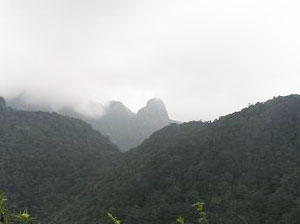 This is a unique area which provided a habitat for many forms of life which are endemic to this mountain range. This very scenic Forest Reserve with its high cliffs and ridges is approximately 21,000 hectares in extent and is under the purview of the Forest Department. The area is threatened by the plantation of Cardamoms as well by encroachments. Knuckles is a good locality to see raptors as well as forest birds. There are many motorable roads that the birder can use. The one which can be recommended for observation of birds in particular is the road from “Loolwatta” passing “Corbett’s Gap” to an ancient village called “Meemure”. The bungalow managed by the Forest Department as well as a few privately owned bungalows are available for over night accommodation.
This is a unique area which provided a habitat for many forms of life which are endemic to this mountain range. This very scenic Forest Reserve with its high cliffs and ridges is approximately 21,000 hectares in extent and is under the purview of the Forest Department. The area is threatened by the plantation of Cardamoms as well by encroachments. Knuckles is a good locality to see raptors as well as forest birds. There are many motorable roads that the birder can use. The one which can be recommended for observation of birds in particular is the road from “Loolwatta” passing “Corbett’s Gap” to an ancient village called “Meemure”. The bungalow managed by the Forest Department as well as a few privately owned bungalows are available for over night accommodation.
Birds to Look for
Mountain Hawk Eagle, Black eagle, Crested Hawk Eagle, Crested Serpent Eagle, Shahin Falcon, Rufus-bellied Hawk Eagle, Crested Honey Buzzard, Ceylon Blue Magpie, Ceylon Whistling Thrush, Ceylon Scimitar Babbler, Dusky Blue Flycatcher, Ceylon Wood Pigeon, Ceylon Hill White Eye, Ceylon Grey Hornbill, Yellow-fronted Barbet, Spotted-winged Thrush and many more.
INGIRIYA/BODINAGALA FOREST RESERVE (DOMBAGASKANDA)
From Colombo this forest can be reached using the following route.
Colombo – Nugegoda – Piliyandala – Horana – 4 km from Horana junction look out for a board stating “Dombagaskanda forest Hermitage (Aranyaya)” Follow the boards to the forest. (1 ½ hours)
This is protected as a Forest Reserve which comes under the purview of the Forest Department and is 449 hectares in extent. This is a forest within which a Buddhist place of worship is located where priests engage in meditation. Observing silence & respecting the requirements of the temple is of paramount importance. This forest is threatened by human encroachments all around. However one is able to walk for about 1 ½ km inside the forest and also ascend a small hillock from where the surrounding forest canopy can be observed. There are well defined paths to walk as well as cement steps to climb the hillock. Even though not as rich as some of the large forests reserves in terms of the diversity of birds this location is popular with the Colombo birders due to its proximity to the city.
Birds to look for
Green-billed Coucal, Ceylon Trogon, Ceylon Crested Drongo, Indian Three-toed Kingfisher, Yellow-fronted Barbet, Black Capped, Yellow Browed & Black Bulbuls, Legge’s Flowerpecker, Black Naped Flycatcher, Large-billed & Green Leaf Warblers, Ceylon & Green Imperial Pigeons, Brown capped & Black Fronted Babblers and many more.
LABUGAMA KALATUWAWA FOREST RESRVE
From Colombo you can reach this forest on the following route.
Colombo – Maharagama – Kaluaggala – Turn Left – Many roads that can be taken to reach the borders of the forest. (1 hour)
This is a lowland, Diptherocarpus dominant, wet ever green rain forest which forms the catchment are of the above two reservoirs which provides water to the city of Colombo. This forest which comes under the purview of the Forest Department is 2,150 hectares in extent and is the largest forest close to Colombo where many wet zone endemic species can be observed. As in the case with any wet zone forest in the country leeches are found here and any excursion in to the forest should be with adequate protection.
Birds to Look for
Green-billed Coucal, Indian Scimitar Babbler, Black-fronted Babbler, Spotted-winged Thrush, Ceylon Trogon, Ceylon Crested Drongo, Ceylon Grey Hornbill, Ceylon Small Barbet, Ceylon Jungle Fowl, Ceylon Spur Fowl, Ceylon Green Pigeon, Emerald Dove, Green Imperial Pigeon, Brown–capped Babbler, Red-backed & Crimson-backed Woodpeckers, Lesser Yellow-naped Woodpecker, Black-capped, Yellow-browed & Black Bulbuls, Layard’s & Alexandrine Parakeets, Ceylon Lorikeet, Indian three-toed Kingfisher, Tickell’s Blue Flycatcher, Brown-capped Pygmy Woodpecker and many more.
SALGALA FOREST
From Colombo this forest can be reached using the following routes.
1. Colombo – Kaduwela – Veliveriya – Attanagalle – Galapitamada – Salgala (1/2 hours)
2. Colombo – Peliyagoda – Warakapola turn right from the junction to - Galapitamada
This is a forested area where a Buddhist place of worship is located similar to Bodinagala. The foot path inside the forest is about ½ km. But the low country, tall forest is rich in bird life.
Birds to look for
White-rumped Shama, Tickell’s Blue Flycatcher, Common Hill Myna, Paradise Flycatcher, Yellow-fronted Barbet, Ceylon Grey Hornbill, Black-naped Flycatcher, Ceylon Small Barbet, Black-headed Cuckoo Shrike, Crimson Backed Woodpecker and many more.
MEETHIRIGALA FOREST RESERVE
From Colombo this forest can be reached using the following route.
Colombo – Kaduwela- Hanwella – Pugoda – After 3 km look for a road to the right with a board “Meethirigala Aranyaya”.
(One hour)
This is protected as a Forest Reserve which comes under the purview of the Forest Department and is 512 hectares in extent. This too is a forest where a Buddhist place of worship is located. The foot path that was found bordering the forest which led to a village few years ago has now become a tarred road. During early morning a walk on this road can be very rewarding and having walked for about 1 ½ km there is a foot path to the left which leads to an open glade. Bird watching inside the forest hermitage area should be with the permission of the care takers.
Birds to look for include
White-rumped Shama, Ceylon Swallow, Ashy Swallow Shrike, Ceylon Lorikeet, Black Capped, Yellow Browed & Black Bulbuls, Ceylon & Green Imperial Pigeons, Alexandrine Parakeet, Brown Capped & Black-fronted Babblers, Black Headed & Large Cuckoo shrikes, Indian Three-toed Kingfisher, Tickells Blue Flycatcher, Paradise Flycatcher, Black-naped Flycatcher and many more.
THALANGAMA TANK & MARSHES
From Colombo this wetland can be reached using the following route.
Colombo – Rajagiriya – Pelawtta - turn right and drive towards Hokandara Junction - turn left about 150m before the junction on to the ITN TV station road. Go pass the ITN TV station – Turn right on to the tank road which will take you to the tank.
(30 minutes)
This area consists of a large tank, marshes, ponds, well wooded privet lands and a series of paddy fields with motorable roads through the area. The area can be explored on foot as well as by a vehicle. Many migrant waders as well as some forest birds can be seen here, particularly, during the beginning and end of the migrant season. It is a popular site among birders due to its proximity to Colombo.
Birds to look for
Stork-billed, Common, Pied & White-breasted Kingfishers, White Ibis, Lesser Whistling Teal, Common Moorhen, Brahminy Kite, Brown Shrike, Ceylon Swallow, Black Winged Stilt, Water Cock, Purple Heron, Gargany, Common, Marsh & Wood Sandpipers, Yellow Wagtail, Indian Black Robin, Lesser Sand Plovers, Red- wattled lapwings, Green Imperial Pigeon & Crested Honey Buzzard etc and many more.
SRI JAYAWARDENAPURA SANCTUARY
From Colombo this sanctuary can be reached using the following route. (20 Minutes)
Colombo – Rajagiriya – 100m before the turn off to the parliament turn right on to the “Japan Friendly Mawatha” - drive for about one km and you will come to some marshy areas to the left.
This area is protected as a sanctuary which comes under the purview of the Department of Wild Life Conservation and is 449 hectares in extent. A walk on the foot paths along the marshes during early mornings, particularly during the migrant season, is worth for those interested in observing some local as well as migrant species. It is also popular due to its close proximity to the city.
Birds to look for
Lesser Whistling Teal, Black Winged Stilt, Eurasian Golden Plover, Lesser sand Plover, Yellow Wagtail, Asian Openbill, Common Kingfisher, Spotted Dove, Pintail Snipe, White-bellied sea eagle, Brahminy Kite, Black-headed Oriole, Ashy & White Browed Prinias, White Breasted Waterhen, Purple Coot, Wood & Common Sandpipers etc and many more.
BELLANVILA - ATTIDIYA SANCTUARY
From Colombo this sanctuary can be reached using the following route.
Colombo – Nugegoda – Papiliyana – drive towards Bellanwila Temple, as you pass the temple turn to your left and after 30 metres turn to your right again. This road goes through the marshes. You can also go pass the temple for about 200m and turn right to wards the “Pump House” of the Water Resources Board from where there is a foot path of a bout 1/2 km in to the marsh along the river.
This wetland which is 372 hectares in extent is protected as a sanctuary and is under the Department of Wild Life Conservation. Even though the effluence from various industrial operations are released to the water ways that flows through the marsh, this, once very rich wet land, yet holds many interesting species of birds.
Birds to look for
Lesser Whistling Teal, Asian Openbill, Purple Heron, Blyth’s Reed Warbler, Pallas Grass hopper Warbler, Ashy & White - browed Prinia, White Ibis, Black -headed Oriole, Purple Coot, Water Cock, Common, Pied, White-breasted & Stork-billed Kingfishers, Black winged Stilt, Spot Billed Pelican, White-breasted Waterhen, Ruddy Crake ect and many more.
UDAWATTAKELE SANCTURY
This sanctuary can be reached from Colombo on the following route.
Colombo – Kegalle- Kandy – take the road which goes up passing the president’s house to reach the entrance.
104 hectares of this forest has been declared as a sanctuary and comes under the purview of the Department of Wild Life Conservation and 119 hectares is protected as a Forest Reserve by the Forest Department. This is a very popular site with the birders in Kandy area. Vehicles are not permitted and ticket has to be obtained to enter the sanctuary. This is a tall, wet evergreen forest. The lake within the sanctuary attracts many species of birds that feed on fish.
Birds to look for
Indian Three-toed Kingfisher, Stork-billed Kingfisher, Common Kingfisher, Brown Fish Owl, Forest eagle Owl, Wood Owl, Common Hill Myna, Tickell’s Blue Flycatcher, Green Leaf & Large-billed Leaf warblers, Layard’s Flycatcher, Paradise Flycatcher, Brown-capped Babbler, Crimson-backed Woodpecker, Yellow-fronted Barbet, Layard’s, Alexandrine & Blossom-headed Parakeets, Ceylon Lorikeet, Indian Pitta and many more.
VICTORIA, RANDENIGALA & RANTAMBE SANCTUARY
This sanctuary can be reached from Colombo on the following route.
Colombo – Kegalle – Kandy – Tennakumbura Bridge – Go straight to reach Raja Mawatha which goes through the sanctuary.
(4 ½ hours)
This is the catchment area for the above three reservoirs that were built under the accelerated Mahaveli development scheme. The area enjoys protection as a Sanctuary which comes under the purview of the Department of Wild Life Conservation and is 42,087 hectares in extent. The forested hills and the valleys as well as the large reservoirs and rivers make this area suitable for many species of forest birds and raptors. Accommodation is available at some private hotels as well as Mahaveli Bungalows.
Birds to look for
Thick-billed Flowerpecker, Black-headed Cuckoo Shrike, Large Cuckoo Shrike, Malabar Pied Hornbill, Ceylon Grey Hornbill, Orange Minivet, Indian Pitta, Ceylon Swallow, House Swift, Forest Eagle Owl, Brown Fish Owl, Black Eagle, Rufous-bellied Hawk Eagle, Crested Serpent & Crested Hawk Eagles, Black-winged Kite, Crested Honey Buzzard, Ceylon Jungle Fowl, Rufus Woodpecker, Common Iora, Green Leaf & Large-billed Leaf Warblers and many more.
INTERMEDIATE AND DRY ZONE FORESTS/TANKS & LAGOONS
These sites will vary form intermediate forests to arid scrub lands and will also include dry zone tanks, Lagoons, mud flats ect. Depending on the time of the year these areas can be quite warm thus it is advisable to carry plenty of water. Shoes are always recommended if the plan is to walk in order to protect the feet from the pin head sized ticks. At the end of the day it is prudent for those who walked in slippers or any foot wear where the feet are exposed to check between the toes for these tiny ticks. Dry zone is also home to a number of species of poisonous snakes, tarantulas ect. Therefore one needs to take precautions not to insert hands in to dark places such as tree holes under decaying logs etc where snakes can be found during the day, and ensure that particularly children are advised not to do the same. Snakes are most active during the late evenings and night time but would always avoid human beings when detected. As they do not have ears they detect movement by the vibrations in the environment with their highly advanced tongues. In the circumstances, treading the floor hard as well as using stick to tap the floor ahead would be help full to avoid them in the night. The other “big issue” in the dry zone is wild elephants. This part of the country is where the human elephant conflict has reached an acute stage. Elephants are active throughout the day, but are most active during dusk and dawn. It is strongly advised to remain inside or close to the vehicles when bird watching in any area where there are wild elephants.
BUNDALA NATIONAL PARK
This park can be reached from Colombo on the following route.
Colombo – Ratnapura – Pelmadulla – Godakawela – Thimbolketiya – Embilipitiya – Turn left at Padalangala – Sisilassagama – Veligatta. Turn right - Park entrance is about 3 km away (6 hours)
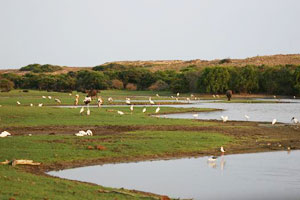 This is the first site in the country to acquire Ramsar status. Bundala is the most important site for resident as well as migrant water birds outside the northern part of the country. Bundala, which comes under the purview of the Department of Wild Life Conservation, was declared as a sanctuary in December 1969 and was granted Ramsar status in October 1990. The park consists of 6,216 hectares of dense thorny scrub, sand dunes and five shallow brackish lagoons. Namely Bundala, Embilikala, Malala, Mahalewaya & Koholankala. The road net work inside the park allows the birder to visit many bird rich sites located within the park in a vehicle. The Bundala saltern which is adjoining the park has a few motorable roads and is a locality where thousands of migrant waders can be observed during the season. There are no bungalows erected inside the park but a few camp sites are available within the park. Accommodation is available at private guest houses at Veligatta as well as at Hambantota.
This is the first site in the country to acquire Ramsar status. Bundala is the most important site for resident as well as migrant water birds outside the northern part of the country. Bundala, which comes under the purview of the Department of Wild Life Conservation, was declared as a sanctuary in December 1969 and was granted Ramsar status in October 1990. The park consists of 6,216 hectares of dense thorny scrub, sand dunes and five shallow brackish lagoons. Namely Bundala, Embilikala, Malala, Mahalewaya & Koholankala. The road net work inside the park allows the birder to visit many bird rich sites located within the park in a vehicle. The Bundala saltern which is adjoining the park has a few motorable roads and is a locality where thousands of migrant waders can be observed during the season. There are no bungalows erected inside the park but a few camp sites are available within the park. Accommodation is available at private guest houses at Veligatta as well as at Hambantota.
Birds to look for
Greater Flamingo, Pintail, Gargany, Shoveller, Little Stint, Ruddy Turnstone, Common, Wood & Marsh Sandpipers, Common Redshank, Greenshank, Curlew Sandpiper, Black-tailed Godwit, Little Pratincole, Black-winged Stilt, Caspian Tern, Lesser Crested Tern, Gull-billed Tern, Little Tern, Great Stone Plover, Little-ringed Plover, Golden Plover, Stone Curlew, Spot-billed Pelican, Spoonbill, Broad-billed Sandpiper, Clamorous Reed Warbler, Ruddy Crake, Black-backed Yellow Woodpecker, Yellow-fronted Pied Woodpecker, Hoopoe, Malabar pied Hornbill, Ceylon Jungle Fowl, Marshall’s Iora and many more.
CHILAW SAND SPITS
This site can be reached from Colombo on the following route.
Colombo-Negombo - Chilaw – turn right at the Chilaw Rest House and go along the coast road to reach the sand spit. Towards the end the surface of the road becomes very sandy and thus it is advisable to park vehicle well in advance if it is not four wheel driven. (2. Hours)
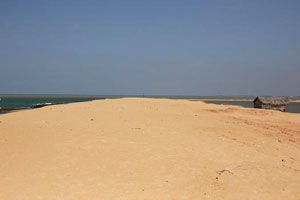 This is a location on the beach next to an estuary and is very good for waders, Terns and Gulls. The main sand spit is to the right of the main land and can be reached by a very short boat ride across the river. Meals and accommodation is available at the Chilaw Rest House which is the only such place close to the site.
This is a location on the beach next to an estuary and is very good for waders, Terns and Gulls. The main sand spit is to the right of the main land and can be reached by a very short boat ride across the river. Meals and accommodation is available at the Chilaw Rest House which is the only such place close to the site.
Birds to look for
Sanderling, Common Tern, Little Tern, Lesser-crested Tern, Great-crested Tern, and Brown- headed Gull, Heuglin’s Gull, Terek Sandpiper, Whimbrel, and Eurasian Curlew and many more.
Even rare species such as Oystercatcher, Sandwich Tern etc have been recorded at this location.
ANAVILUNDAWA SANCTUARY
This sanctuary can be reached from Colombo on the following route.
Colombo – Negombo – Chilaw – 10-12km turn left at a small Buddhist shrine. Upon turning to this road the Anavilundawa Railway station is on to the right - Proceed one km to reach the tank. (2 ½ hours)
This sanctuary which comes under the Department of Wild Life Conservation is 1,397 hectares in extent. It is primarily a complex of large tanks and adjoining forest. The largest of the tanks holds a large breeding colony of Herons and other water birds mainly during the months of April – June. The dominant species is the Openbill but Great Cormorant, White Ibis and a whole host of other species breed here. A walk on the bund of this tank will permit one to get close to the breeding colony. During the season many species of migrants can also be observed here. A spotting scope would add much value to get the most out of this locality. Meals and accommodation for those interested in staying over night is avaible at the Chilaw or Puttlam Rest House as well as at private guest houses in the area.
Birds to look for
Openbill, Purple Coot, Common Moorhen, Lesser Whistling Teal, Purple Heron, Grey Heron, Stork-billed, Common, Pied & White-breasted Kingfishers, Gargany, White-bellied Sea Eagle, Grey-headed Fish Eagle, Black-winged Stilt, Cotton Teal, Indian Shag, Spoonbill, Large, Median & Little Egrets, Black-backed Yellow Woodpecker, Brown Fish Owl and many more.
NAWADANKULAMA TANK
This tank can be reached from Colombo on the following route.
Colombo – Negombo – Chilaw – look for a Board on the left “Nawadankulama” at105TH km Post- turn right – 3km to the tank.
(3 hours)
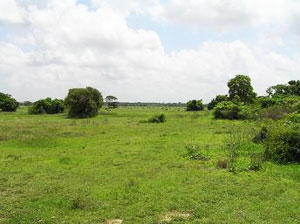 This is a very large tank which is devoid of water during the dry season exposing large area of lake shore studded with small islands of trees and shrubs. This is the southern most location in the country where some of the species which are commonly found in the northern part of the country such as the Collared Dove, Indian Grey Partridge can be regularly seen. It is also a location which is favoured by large flocks of migrant ducks. One could walk on the bund as well as drive passing the main turn to the bund and drive down to the dried up tank shore. Meals & accommodation is available at the Puttlam Rest House as well as some private hotels.
This is a very large tank which is devoid of water during the dry season exposing large area of lake shore studded with small islands of trees and shrubs. This is the southern most location in the country where some of the species which are commonly found in the northern part of the country such as the Collared Dove, Indian Grey Partridge can be regularly seen. It is also a location which is favoured by large flocks of migrant ducks. One could walk on the bund as well as drive passing the main turn to the bund and drive down to the dried up tank shore. Meals & accommodation is available at the Puttlam Rest House as well as some private hotels.
Birds to look for
Collared Dove, Indian Grey Partridge, Pintail, Gargany, Osprey, Black-tailed Godwit, Wood Sandpiper, Little Grebe, Cotton Teal, Common Coot, Brown Fish Owl, Grey-headed Fish Eagle, White-bellied Sea Eagle, Crested Hawk Eagle, Crested Serpent Eagle, Black-backed Yellow Woodpecker, Golden-backed Woodpecker, Orange-breasted Green Pigeon, Purple Heron, Grey Heron, Blue-faced Malkoha, Indian Pitta, and Crested Tree Swift.
WILPATTU NATIONAL PARK
This park can be approached from Colombo on the following route.
Colombo – Negombo – Chilaw – Puttlam – Tabbowa – turn left at the Wilpattu board few Kilometers before the Nochchiyagama town. (4 hours)
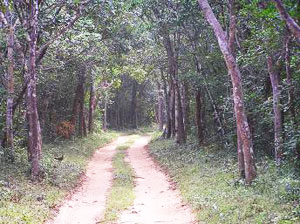 Wilpattu was originally declared as a Sanctuary in 1905 and upgraded as a National Park in February 1938. Wilpattu north Sanctuary was declared in November 1947. With an extent of 131,693 hectares, this is the largest National Park in the country. The main topographical feature in Wilpattu is the concentration of “villus” or lakes within the park. These water bodies though looking similar to lakes are formed by flat basin like depressions with the surface containing purely rain water. The park is unique in having a number of these with large sandy lake shores (Villus) which provide the animals with a continuous water supply during the dry season. Two of these “villus” are saline due to a characteristic of the soil. A permit is needed to be purchased at the entrance and a game guard is also provided by the Department of Wild Life Conservation. Except at a few locations, visitors are not permitted to get off their vehicles. This is a very scenic park. There are bungalows inside the park which has to be pre booked through the Department of Wild Life Conservation. There are a few privately owned bungalows out side the park as well.
Wilpattu was originally declared as a Sanctuary in 1905 and upgraded as a National Park in February 1938. Wilpattu north Sanctuary was declared in November 1947. With an extent of 131,693 hectares, this is the largest National Park in the country. The main topographical feature in Wilpattu is the concentration of “villus” or lakes within the park. These water bodies though looking similar to lakes are formed by flat basin like depressions with the surface containing purely rain water. The park is unique in having a number of these with large sandy lake shores (Villus) which provide the animals with a continuous water supply during the dry season. Two of these “villus” are saline due to a characteristic of the soil. A permit is needed to be purchased at the entrance and a game guard is also provided by the Department of Wild Life Conservation. Except at a few locations, visitors are not permitted to get off their vehicles. This is a very scenic park. There are bungalows inside the park which has to be pre booked through the Department of Wild Life Conservation. There are a few privately owned bungalows out side the park as well.
Birds to look for
Brown-capped Babbler, White-rumped Shama, Ceylon Grey Hornbill, Pintail Snipe, Ceylon Jungle Fowl, Black-tailed Godwit, Great Stone Plover, Little Ringed Plover, Ceylon Green Pigeon, Orange-breasted Green Pigeon, Malabar Pied Hornbill, Racket-tailed Drongo, Forest Eagle Owl, Brown Fish Owl, Black-backed Yellow Woodpecker, Rufus Woodpecker, Golden-backed Woodpecker, Hoopoe, Common Kestrel, Crested Hawk Eagle, Crested Serpent Eagle, White-bellied Sea Eagle, Grey-headed Fish Eagle, Ceylon Frog Mouth and many more.
MANNAR & VANKALAI SANCTUARY
This sanctuary can be approached from Colombo on the following route.
Colombo – Negombo – Chilaw – Puttlam – Anuradapura – Medawachchiya – Settikulam – Murunkan – Mannar (6 hours)
This is one of the most important areas located in the north of the country for the migrating waterfowl. 4,800 hectares of this very important habitat was protected and declared as a sanctuary on 9th September 2008 upon a proposal presented to the Department of Wild Life Conservation after a four year study conducted by the members of the Ceylon Bird Club. During the study the members discovered that the Indian Spot-billed Duck, a species which was considered a very rare migrant with a history of only a handful of records breeding in this area. This is an arid locality with seasonal water bodies, marshes, lakes, mudflats, thorny scrub, salt marshes, swamps, mangroves, coastal lagoons and sea grass beds. Some of the migrant water fowl species which are commonly seen here are seldom seen in the south of the country. The CBC proposal that Vankalai is also given Ramsar status as it supports a very large population of migrant waterfowl during the season has been accepted and Vankalai sanctuary has now been declared a Ramsar site. A good spotting scope is of immense value to the avid birder who wants to study the many species of waders found at the causeway as well as the many water bodies in Mannar. There are no hotels yet for over night stay. The over night accommodation available is mostly the rooms of the houses rented out by the owners.
BIRD STATISTICS OF VANKALAI 2003-2010 WITH RAMSAR REQUIRMENT
- 80,000+ WATER BIRDS DURING 3 RECENT SEASONS
- GREATER FLAMINGO - RAMSAR 1% REQUIRMENT 2,400 COUNTED 5,000
- EURASIAN WIGEON - RAMSAR 1% REQUIRMENT 2,500 COUNTED 56,000
- NOTHERN PINTAIL - RAMSAR 1% REQUIRMENT 20,000 COUNTED 95,000
- BLACK TAILED GODWIT - RAMSAR 1% REQUIRMENT 1,500 COUNTED 4000
Birds to look for
Indian Spot-billed Duck, Eurasian Wigeon, Avocet, Common Teal, Northern Shoveller, Pintail, Gargany, Greater Flamingo, Crab Plover, Oystercatcher, Red Knot, Great Knot, Ruff, Indian Grey Partridge, Lesser Crested Tern, Great Crested Tern, Caspian Tern, White-winged Black Tern, Little Tern, Great Black-headed Gull, Heuglin’s Gull, Brown Headed Gull, Common Coot, Bar-tailed Godwit, Kentish Plover, Black Drongo, Rufous Rumped Shrike, Collared Dove, Hoopoe, Montague’s Harrier, Pallid Harrier, Peregrine Falcon, Golden-backed Woodpecker and many more.
GIANT’S TANK SANCTUARY
This sanctuary can be approached from Colombo on the following route.
Colombo – Negombo – Chilaw – Puttlam – Anuradapura – Medawachchiya – Settikulam – Murunkan – Giant’s Tank (5 ½ hours)
As indicated by the name this is a very large expanse of water most of which dries up during the non rainy season. The tank and part of the adjacent forest which is 4,330 hectares in extent is protected as a Sanctuary and comes under the Department of Wild Life Conservation. Observing birds here is mostly from climbing on the bund which is by the road with, ideally a good spotting scope or by boat. There no suitable places around the sanctuary except to stay over in Mannar.
Birds to look for
Openbill, Common Coot, Pheasant-tailed Jacana, Cotton Teal, Rufous-rumped Shrike, Black Drongo, Collared Dove, Pintail, Gargany, Kestrel, Great Cormorant, Striated Weaver, Baya Weaver, Spot-billed Pelican, Purple Coot and many more.
JAFFNA PENINSULA
This area can be approached from Colombo on the following route.
Colombo- Kurunegala – Dambulla – Mihintale – Medawachchiya – Vauniya – Kilinochchi – Elephant pass – Jaffna. (8-9 hours)
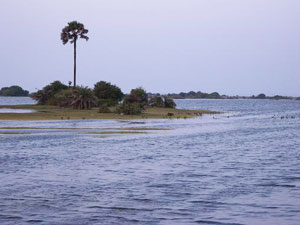 The Jaffna Peninsular with its numerous water bodies has always been a haven for migrant waterfowl. The many water bodies which teem with migrant waterfowl become dried up grass lands during the non migrant season. It is this grass that the “upending” ducks feed on so voraciously during their stay here. A drive towards Kaits, Manalkadu at Point Pedro as well as the Avranghal Plains and the Kaithardy Bridge are some of the more important localities which should be visited by a bird keen visitor to the peninsula. There are many places which provide meals and accommodation in Jaffna.
The Jaffna Peninsular with its numerous water bodies has always been a haven for migrant waterfowl. The many water bodies which teem with migrant waterfowl become dried up grass lands during the non migrant season. It is this grass that the “upending” ducks feed on so voraciously during their stay here. A drive towards Kaits, Manalkadu at Point Pedro as well as the Avranghal Plains and the Kaithardy Bridge are some of the more important localities which should be visited by a bird keen visitor to the peninsula. There are many places which provide meals and accommodation in Jaffna.
Birds to look for
Eurasian Wigeon, Nothern Shoveller, Common Teal, Pintail, Gargany, Great Black-headed Gull, Heuglin’s Gull, Greater Flamingo, Whimbrel, Bar-tailed Godwit, Black-tailed Godwit, Golden-backed Woodpecker, Indian Grey Partridge, Collared Dove, Black Drongo, Eurasian Curlew, Terek Sandpiper, Black Kite, Osprey and many more.
CHUNDIKULAM SANCTURY
This sanctuary can be reached from Colombo on the following route.
Colombo- Kurunegala – Dambulla – Mihintale – Medawachchiya – Vauniya – Kilinochchi – Elephant pass – Jaffna – Chundikulam.
(8-9 hours)
This used to be one of the most popular bird sanctuaries in the north of the country. It is 11,149 hectares in extent and comes under the purview of the Department of Wild Life Conservation. It is primarily the lagoon and the surrounding area. This are was not accessible during the pass three decades due to the armed conflict and currently the armed forces are engaged in clearing the land mines.
Birds to look for
Greater Flamingo, Eurasian Wigeon, Common Teal, Pintail, Garganey, Shoveller, Bar-tailed Godwit, Black-tailed Godwit, Eurasian Curlew, Common, Wood & Marsh Sandpipers, Terek Sandpiper, Curlew Sandpiper, Black-winged Stilts, Brown-headed Gull, Gull-billed Tern, Ruff and many more.
UDAWALAWA NATIONAL PARK
This park can be reached from Colombo on the following route.
Colombo – Ratnapura – Pelmadulla – Kahawatta – Madampe – Kolambage ara – Udawalwa Junction – turn left to Udawalawa.
(4 hours)
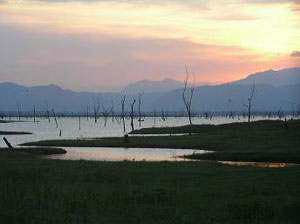 Udawalawa was declared as the fifth National Park of the country in June 1972 and is very famous worldwide for its large population Asian Elephants. This is one of the National Parks which is closest to Colombo and provides diverse habitat for many species of birds. It lies both in the Sabaragamuwa and Uva Provinces and includes the Udawalawa reservoir and most of its catchment area as well. The altitude ranges from 100m to 373m and the park covers an area of 30,821 hectares and is supported by not only the large reservoir but one of the country’s major rivers which flows through the same. The ecosystem of the park is predominantly forest with large scattered areas of grasslands and thorny-shrubs while tall forests exist mostly close to the river. There are bungalows for overnight stay inside the park as well as camping sites which have to be pre booked through the Colombo office of the Department of Wild Life Conservation (DWLC). There are also many privately owned bungalows as well as guest houses around the park.
Udawalawa was declared as the fifth National Park of the country in June 1972 and is very famous worldwide for its large population Asian Elephants. This is one of the National Parks which is closest to Colombo and provides diverse habitat for many species of birds. It lies both in the Sabaragamuwa and Uva Provinces and includes the Udawalawa reservoir and most of its catchment area as well. The altitude ranges from 100m to 373m and the park covers an area of 30,821 hectares and is supported by not only the large reservoir but one of the country’s major rivers which flows through the same. The ecosystem of the park is predominantly forest with large scattered areas of grasslands and thorny-shrubs while tall forests exist mostly close to the river. There are bungalows for overnight stay inside the park as well as camping sites which have to be pre booked through the Colombo office of the Department of Wild Life Conservation (DWLC). There are also many privately owned bungalows as well as guest houses around the park.
Birds to look for
Large prinia, White-browed Prinia, Ashy Prinia, Franklins Prinia, Yellow-eyed Babbler, White-throated Babbler, White-rumped Shama, Brown-capped Babbler, Black-fronted Babbler, Common & Marshall’s Iora, Ceylon Grey Hornbill, Blue-faced Malkoha, White-necked Stork, Lesser Adjutant Stork, Blyth’s Pipit, Crested Honey Buzzard, Crested Hawk Eagle, Crested Serpent Eagle, Black-winged Kite, White-bellied Sea Eagle, Grey-headed Fish Eagle, Sirkeer, Hoopoe, Velvet-fronted Nuthatch, Pied Flycatcher Shrike, Black-capped Bulbul, Barred Bustard Quail, Indian Pea Fowl, Alpine Swift, House Swift, Great Stone Plover, Lesser Sand Plover, Orange-headed Ground Thrush, Forest Eagle Owl, Brown Wood Owl, Brown Fish Owl, Barn Owl, Little Scops Owl, Stork-billed Kingfisher, Indian Pitta, Common Kingfisher, Openbill, Painted Stork, Spoonbill, Rosy Starling, Ceylon Jungle Fowl and many more.
SIGIRIYA SANCTUARY
This sanctuary can be reached from Colombo on the following route.
Colombo – Warakapola – Turn Left – Kurunegala – Dambulla – Kimbissa – Turn Right – Sigiriya. (4 hours)
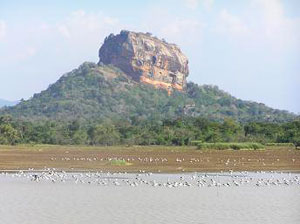 This is an area surrounding a very famous and regularly visited cultural site in the country. The sanctuary covers an area of 5,099 hectares of forest as well as water bodies around the Sigiriya rock. There are motorable roads around the site as well as towards Pidurangala. There are many hotels and guest houses which offer meals and accommodation.
This is an area surrounding a very famous and regularly visited cultural site in the country. The sanctuary covers an area of 5,099 hectares of forest as well as water bodies around the Sigiriya rock. There are motorable roads around the site as well as towards Pidurangala. There are many hotels and guest houses which offer meals and accommodation.
Birds to look for
Shahin Falcon, Little Scops Owl, Indian & Long-tailed Night-Jar, Forest Eagle Owl, Openbill, Ceylon & Orange-breasted Green Pigeon, Green Imperial Pigeon, Emerald Dove, Ceylon Jungle Fowl, Orange-headed Ground Thrush, Indian Blue Chat, Brown-capped Babbler, White-rumped Shama, Black-capped Bulbul, Tickell’s Blue Flycatcher, Brown Flycatcher, Layard’s Flycatcher, Orange Minivet, Small Minivet, Malabar Pied Hornbill, Ceylon Grey Hornbill, White-bellied sea Eagle, Crested Serpent & Crested Hawk eagle, Blue-faced Malkoha and many more.
LUNUGAMVEHERA NATIONAL PARK
This park can be reached from Colombo on the following route.
Colombo – Ratnapura – Pelmadulla – Godakawela – Sankapala - Turn left at the Udawalawa Junction and proceed along the National park – Tanamalwila – Turn right – Look for the park board - entrance is a few km from Tanamalwila Junction. (5 hours)
This is the immediate catchment of the Lunugamvehera reservoir and is 23,498 hectares in extent with 14% being the reservoir. This park links the Yala protected area complex on its east and Udawalawa National Park to its west and was declared in December 1995. The vegetation includes dry forests, open thorny scrub and grass lands. The large tank, small water bodies and the water ways make this location very good for birds. There are two bungalows for visitors interested in staying over night in side the park which has to be pre booked at the DWLC head office in Colombo.
Birds to look for
Chestnut-headed Bee-eater, Blue-faced Malkoha, Spot-billed Pelican, Malabar Pied Hornbill, Painted Stork, White-necked Stork, Marshall’s Iora, Jungle Owlet, Barred Bustard Quail, Indian Peafowl, Crested Honey Buzzard, Crested Hawk Eagle, Crested Serpent Eagle, White-bellied sea Eagle, Grey-headed Fish Eagle, Indian Pitta and many more.
YALA OR RUHUNU NATIONAL PARK
This site can be reached from Colombo on the following routes.
- Colombo – Galle – Matara – Tangalle – Tissamaharama – Kirinda – Yala
- Colombo – Ratnapura – Pelmadulla – Kahawatte – Udawalwa Junction – Embilipitiya – Veligattha Junction – Turn right towards Bundala National Park – Kirinda – Yala. (5 ½ - 6 hours)
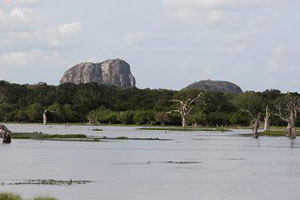 Yala or Ruhunu National Park is one of the best and most popular parks in the country due to its diversity and density of mammals. It consists of five blocks covering an area of 97,881 hectares. Block 1, which was established in February 1938 and covers an area of 14,101 hectares, is widely used by tourists due to its very extensive network of roads. Block II was established in September 1954, Block III in April 1967, Block IV in October 1969 and Block V in October 1973. The vegetation of the park is primarily semi arid thorn scrub interspersed with riverine forests and fairly dense pockets of forests. There are many places to stay just out side the park in Palatupana as well as a number of bungalows in side the park. These bungalows, as with the case of all national park bungalows, and camp sites have to be pre booked at the head office of the DWLC and a cook and a caretaker are provided and the visitors are required to take all the rations needed. As with all most all National Parks, excluding the Horton Plains National park, a permit and a guide should be obtained at the park entrance.
Yala or Ruhunu National Park is one of the best and most popular parks in the country due to its diversity and density of mammals. It consists of five blocks covering an area of 97,881 hectares. Block 1, which was established in February 1938 and covers an area of 14,101 hectares, is widely used by tourists due to its very extensive network of roads. Block II was established in September 1954, Block III in April 1967, Block IV in October 1969 and Block V in October 1973. The vegetation of the park is primarily semi arid thorn scrub interspersed with riverine forests and fairly dense pockets of forests. There are many places to stay just out side the park in Palatupana as well as a number of bungalows in side the park. These bungalows, as with the case of all national park bungalows, and camp sites have to be pre booked at the head office of the DWLC and a cook and a caretaker are provided and the visitors are required to take all the rations needed. As with all most all National Parks, excluding the Horton Plains National park, a permit and a guide should be obtained at the park entrance.
Birds to look for
Black-necked Stork, Lesser Adjutant Stork, White-necked Stork, Openbill, Hoopoe, Malabar Pied Hornbill, Ceylon Grey Hornbill, Orange-breasted Green Pigeon, Rosy Starling, European Bee-eater, Orange-headed Ground Thrush, Blue-faced Malkoha, Red-backed, Black-backed Yellow, Yellow-fronted Pied and Brown-capped Pygmy Woodpeckers, Indian Pitta, Lesser Whistling Teal etc and many more.
KUMANA - YALA EAST NATIONAL PARK
This site can be reached from Colombo on the following routes.
- Colombo – Ratnapura – Pelmadulla – Godakawela – Thimbolketiya – Udawalawa – Tanamalwila – Wellawaya - Monaragala – Pottuvil – Panama – Okanda (Park Office)
- Colombo – Ratnapura – Pelmadulla – Balangoda – Hademmulla – Beragala – Koslanda - Wellawaya – Monaragala – Pottuvil – Panama – Okanda (Park Office) ( 7-8 hours)
The water bodies and mangroves of Kumana provide particularly a very important habitat for birds. Block II of the park was established in December 1969 and Block I in January 1970. The total extent of the park is 18,149 hectares with Block I consisting of 17,863 and Block II consisting only 265.3. The main feature this park is renowned for is the 200 hectare mangrove swamp which teams with nesting birds in May-June. It is surrounded by plains and jungle. There are saline large lagoons along the coast, often surrounded by extensive plains. The vegetation is mostly semi-arid thorn scrub with large areas of dense forest. DWLC is in the process of re building the bungalows at this park. The camp sites have to be pre booked. There are many places to stay over night in Arugambay/Pottuwil.
Birds to look for
Lesser Whistling Teal, Spot-billed Pelican, Openbill, Purple Coot, Pheasant-tailed Jacana, Common Coot, Grey Heron, Purple Heron, Black-winged Stilt, Yellow-wattled Lapwing, Jungle Owlet, Black-necked, White-necked & Painted Storks, Pintail, Garganey, Common Red shank, Greenshank, Wood, Common & Green Sandpipers etc and many more.
KALAMETIYA SANCTUARY
This site can be reached from Colombo on the following route.
Colombo – Ratnapura – Pelmadulla – Godakawela – Embilipitiya – Padalangala (turn left) – Sisilassagama (Turn Right) – Kalametiya. (5 hours)
This is a haven for many species of resident as well as migrant water birds including many species of migrant ducks. The area is protected as a Sanctuary by the Department of Wild Life Conservation and is 712 hectares in extent. The area is primarily covered with reed beds, water bodies, grass fields, marshes etc which can be approached using the net work of roads that cuts across the sanctuary. Currently permits are not required to enter the area and bird watching sits can be reached by vehicle.
Birds to look for
Glossy Ibis, White Ibis, Painted Snipe, Large Sand Plover, Ruddy Turn Stone, Clamorous Reed Warbler, Water Cock, Ruddy Crake, Pintail, Gargany, Black-winged Stilt, Little Pratincole, Alpine Swift, Common Redshank, Greenshank, Wood, Common & Green Sandpipers.
WASGAMUWA NATIONAL PARK
This site can be reached from Colombo on the following routes.
- Colombo – Kandy – Raja Mawatha – Mahiyangana – Wilgamuwa – Park entrance.
- Colombo – Kandy – Matale – Riverston – Hettipola – Wilgamuwa – Park entrance. (6 hours)
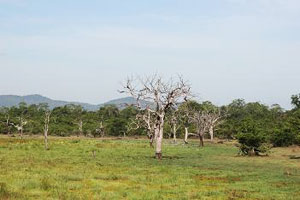 The accelerated Mahaveli Development Project resulted in the clearing of vast areas of forest and thus depriving many species of wild life of its homelands. This park was established the conserve the bio diversity of this area thus effected by this project. It was declared as a National Park in August 1984 and the total area of the park is 33,766 hectares. The vegetation is tropical dry mixed evergreen forest with large open plains. The dense forest cover, the hilly ridges such as the “sudukanda” range and well-developed riverine forests make this park an important locality for avifauna. There are camp sites as well as bungalows in side the park which have to be pre-booked at the DWLC office in Colombo.
The accelerated Mahaveli Development Project resulted in the clearing of vast areas of forest and thus depriving many species of wild life of its homelands. This park was established the conserve the bio diversity of this area thus effected by this project. It was declared as a National Park in August 1984 and the total area of the park is 33,766 hectares. The vegetation is tropical dry mixed evergreen forest with large open plains. The dense forest cover, the hilly ridges such as the “sudukanda” range and well-developed riverine forests make this park an important locality for avifauna. There are camp sites as well as bungalows in side the park which have to be pre-booked at the DWLC office in Colombo.
Birds to look for
Red-faced Malkoha, Blue –faced Malkoha, Red winged Crested Cuckoo, Ceylon Trogon, Indian Cuckoo, Drongo Cuckoo, Indian Pitta, White-necked & Painted Stork, Striated & Baya Weavers, Crested Serpent & Crested Hawk Eagles, White-bellied Sea Eagle, Grey-headed Fish Eagle, Forest Eagle Owl, brown Fish Owl, Little Scops Owl, Paradise Flycatcher, Thick-billed Flowerpecker.
GAL OYA NATIONAL PARK
This park can be reached from Colombo on the following route.
Colombo – Ratnapura – Pelmadulla – Godakawela – Udawalwa – Tanamalwila – Wellawaya – Monaragala – Iginiyagala.
This National Park was established in February 1954 mainly to protect the catchment area of Senanayaka Samudra Reservoir and was handed over to the Department of Wild Life Conservation in 1965. It is 25,900 hectares in extent. Approximately 45% of the park is covered with forests, 33% with savana, 9% grass lands and the balance in water bodies. The park does not have any bungalows within its premises but the Department offers one bungalow which is situated out side the park at Ekgal Aru. There are camp sites in side the park at Kossapola and “Makara”. The latter being on the sandy banks of the gal oya over looking the reservoir one the most scenic places to camp. The Savanna forest areas can be approached from Bibile – Ampara road with a turn off at Karandugala to reach the Nilgala Wild Life beat office.
Birds to look for
Painted Partridge, Jungle Bush Quail, Yellow-legged Green Pigeon, Ceylon Frogmouth, Brown Fish Owl, Southern Sirkeer, Scaly-bellied Woodpecker, Brown-capped Pygmy Woodpecker, Ceylon Spurfowl, Southern Sirkeer, Racket-tailed Drongo, Crested Serpent & Crested Hawk Eagles, White-bellied sea Eagle, Grey-headed Fish Eagle, Forest Eagle Owl, Fish Owl, Little Scops Owl, Paradise Flycatcher, and Thick-billed Flowerpecker.
MINNERYA - GIRITALE NATIONAL PARK
This park can be reached from Colombo on the following route.
Colombo – Warakapola – turn to the left on to Kurunegala road – Kurunegala – Dambulla – Habarana – turn right to the Polonnaruwa road – about 20 km to park entrance.
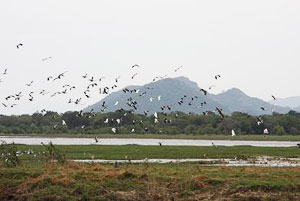 This area was declared a s a sanctuary in July 1938 and was upgraded to a National Park in August 1997. The park is 8,885 hectares in extent and the core of this park holds one of the country’s most diverse natural systems with intermediate forests, bamboo stands, patanas and talawas. The tank supports a wide variety of waterfowl. The vegetation consists of dry mixed evergreen forests, abandoned chena cultivation lands, grass lands and wet lands. The park is famous for the large numbers of Asian Elephants that can be observed on the dry exposed lake shore referred to as the “gathering” that can be witnessed during the dry season.
This area was declared a s a sanctuary in July 1938 and was upgraded to a National Park in August 1997. The park is 8,885 hectares in extent and the core of this park holds one of the country’s most diverse natural systems with intermediate forests, bamboo stands, patanas and talawas. The tank supports a wide variety of waterfowl. The vegetation consists of dry mixed evergreen forests, abandoned chena cultivation lands, grass lands and wet lands. The park is famous for the large numbers of Asian Elephants that can be observed on the dry exposed lake shore referred to as the “gathering” that can be witnessed during the dry season.
Birds to look for
Openbill Stork, Painted Stork, White-necked Stork, Great Stone Plover, Lesser Sand Plover, Crested Serpent & Crested Hawk Eagles, White-bellied Sea Eagle, Grey-headed Fish Eagle, Golden Plover, Spoonbill, White Ibis, Stork-billed Kingfisher, White-rumped Shama
KAUDULLA NATIONAL PARK
This park can be reached from Colombo on the following route.
Colombo – Warakapola – turn to the left on to Kurunegala road – Kurunegala – Dambulla – Habarana – drive straight about 12 km and look for a road to the left to reach the park entrance.
This National Park which is 6,900 hectares in extent and the Kaudulla Minneriya Jungle Corridor which is 8,777 hectares in extent is protected by the Department of Wild Life Conservation. The visitors are mostly those interested in observing Asian Elephants which gather on the lake shore to feed and drink at the reservoir. But the park is rich in bird life too.
Birds to look for
Openbill Stork, Painted Stork, Great Stone Plover, Lesser Sand Plover, Crested Serpent & Crested Hawk Eagles, White-bellied Sea Eagle, Grey-headed Fish Eagle, Spoonbill, White Ibis, Stork-billed Kingfisher.
RITIGALA STRICT NATURAL RESERVE
This reserve can be reached from Colombo on the following route.
Colombo – Warakapola – turn to the left on to Kurunegala road – Kurunegala – Dambulla – Habarana – turn left to the Anuradapura road – drive about 20 km and look for a road to the left with the name board to reach beginning of the foot path.
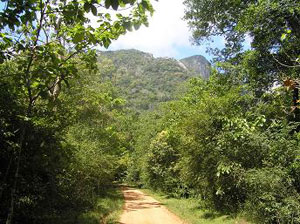 This is a unique isolated mountain forest which is located in the dry zone but holds many species of flora and fauna which are found in the wet zone. It is granted the highest protection by the Department of Wild Life Conservation as a Strict Natural Reserve and is 1,528 hectares in extent. Even though a vehicle can reach the foot of the mountain exploring the same has to be done on foot.
This is a unique isolated mountain forest which is located in the dry zone but holds many species of flora and fauna which are found in the wet zone. It is granted the highest protection by the Department of Wild Life Conservation as a Strict Natural Reserve and is 1,528 hectares in extent. Even though a vehicle can reach the foot of the mountain exploring the same has to be done on foot.
Birds to look for
Black-capped Bulbul, Black Bulbul, Brown-capped Babbler, Malabar Pied Hornbill, Ceylon Grey Hornbill, Black-naped Flycatcher, Thick-billed Flowerpecker, Black Eagle, Crested Serpent & Crested Hawk Eagle, Common Hill Mynah, Indian Pitta, White-rumped Shama.